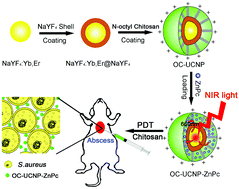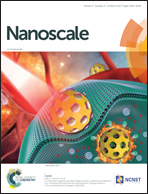Dual antibacterial activities of a chitosan-modified upconversion photodynamic therapy system against drug-resistant bacteria in deep tissue†
Abstract
Photodynamic therapy (PDT) has recently been proposed as an innovative approach to combat multi-drug resistant (MDR) bacteria. To improve the penetration depth of current PDT, a core–shell upconversion nanoparticle (UCNP) based PDT system, composed of a cationic N-octyl chitosan (OC) coated UCNP loaded with the photosensitizer zinc phthalocyanine (OC-UCNP-ZnPc), was constructed to enhance the antibacterial efficacy against MDR bacteria in deep tissue. The core–shell UCNPs displayed a higher upconversion fluorescence efficiency compared to the inner UCNP core. Dual antibacterial activities induced by chitosan and PDT-induced ROS were demonstrated, independent of the bacterial species. In particular, these nanoconstructs exhibited excellent antibacterial effects on the MDR bacteria including methicillin-resistant Staphylococcus aureus (MRSA) and β-lactamase-producing Escherichia coli. In vivo antibacterial therapy for murine MRSA-infected abscesses in the deep tissue (1 cm) strongly confirmed the outstanding anti-MRSA efficacy of OC-UCNP-ZnPc. Our results indicated that the OC-UCNP-ZnPc based PDT system triggered by deep-penetrating NIR light has a prominent antibacterial effect on MDR bacteria, which could be a promising strategy for deep-tissue infections.



 Please wait while we load your content...
Please wait while we load your content...